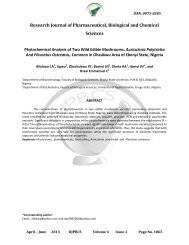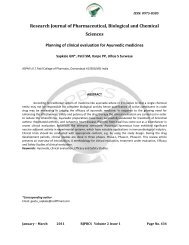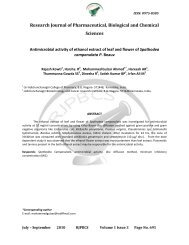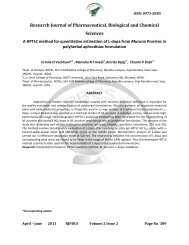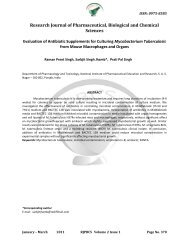Research Journal of Pharmaceutical, Biological and ... - RJPBCS
Research Journal of Pharmaceutical, Biological and ... - RJPBCS
Research Journal of Pharmaceutical, Biological and ... - RJPBCS
You also want an ePaper? Increase the reach of your titles
YUMPU automatically turns print PDFs into web optimized ePapers that Google loves.
ISSN: 0975-8585<br />
Gossypium barbadense: (Family: Malvaceae; Common name:Pima cotton). It is a tropical<br />
perennial plant that produces yellow flowers <strong>and</strong> has black seeds. A study has shown that the<br />
leaf extract <strong>of</strong> the plant decreased the tension <strong>of</strong> phenylephrine-stimulated isolated guinea pig<br />
aorta rings by 15 to 35%. In Suriname's traditional medicine, the leaves <strong>of</strong> the plant are used to<br />
treat HTN <strong>and</strong> delayed/irregular menstruation. [25]<br />
Hibiscus sabdariffa: (Family: Malvaceae; Common name: Roselle). This happens to be one <strong>of</strong><br />
the most extensively studied plants for antihypertensive properties. The leaves, calyx, <strong>and</strong><br />
corolla <strong>of</strong> this plant are used traditionally in many West African countries for various medicinal<br />
purposes <strong>and</strong> as edibles. The antihypertensive effect <strong>of</strong> this plant extract has been variously<br />
studied. One study reported the antihypertensive effect <strong>of</strong> calyx <strong>of</strong> HS. [48, 49, 50, 51]<br />
Lav<strong>and</strong>ula stoechas: (Family: Lamiaceae; Common name: French Lavender). Crude extract <strong>of</strong> L.<br />
stoechas has been reported to produce a fall in BP <strong>and</strong> HR in anesthetized NMT rats.<br />
Pretreatment <strong>of</strong> atropine abolished the cardiovascular responses, suggesting that the<br />
antihypertensive <strong>and</strong> bradycardia effects <strong>of</strong> the crude extract may be mediated through<br />
mechanism(s) similar to that <strong>of</strong> acetylcholine. [52]<br />
Lepidium latifolium: (Family: Cruciferae; Common name: Rompepiedra or Stone breaker). This<br />
plant has been used as a folk medicine in the Canary Isl<strong>and</strong>s for renal lithiasis. It has been found<br />
to have hypotensive effect due to its diuretic action in rat. [53]<br />
Linum usitatissimum: (Family: Linaceae; Common name: Linseed, Flaxseed). It is an annual herb<br />
believed to have originated in Egypt. Linseed <strong>and</strong> its oil are rich in α-linolenic acid, an essential<br />
fatty acid that appears to be beneficial for the heart diseases, inflammatory bowel disease,<br />
arthritis, <strong>and</strong> other health problems. α-linolenic acid belongs to a group <strong>of</strong> substances called<br />
omega-3 fatty acids. Several studies suggest that diets rich in omega-3 fatty acids lower BP<br />
significantly in people with HTN. [54]<br />
Lumnitzera racemosa: (Family: Combretaceae; Common name: Black Mangrove). It is a<br />
h<strong>and</strong>some shrub or a small tree found on the coast <strong>of</strong> India <strong>and</strong> on the Andaman <strong>and</strong> Nicobar<br />
Isl<strong>and</strong>. According to folk medicine, the fruits <strong>of</strong> this plant are curative in skin disorders <strong>and</strong><br />
useful for treating snake <strong>and</strong> insect bites. Antihypertensive action has been reported for the<br />
aqueous acetone extract <strong>of</strong> the plant. The antihypertensive activity <strong>of</strong> eleven hydrolysable<br />
tannins contained in the leaves <strong>of</strong> L. racemosa has been investigated. From the screening in<br />
spontaneously hypertensive rats, corilagin, castalagin, <strong>and</strong> chebulinic acid were identified as<br />
the major active substances. [55]<br />
Lycopersicon esculentum: (Family: Solanaceae; Common name: Tomato). Tomato extract<br />
contains carotenoids, such as lycopene, beta carotene, <strong>and</strong> vitamin E, which are known as<br />
effective antioxidants, to inactivate free radicals <strong>and</strong> to slow the progress <strong>of</strong> atherosclerosis. A<br />
study showed that extract <strong>of</strong> tomato (Lyc-O-Mato) modestly reduces BP in patients with mild,<br />
untreated HTN. A significant correlation has been observed between systolic BP <strong>and</strong> lycopene<br />
levels. Tomato extract when added to patients treated with low doses <strong>of</strong> ACE inhibition,<br />
calcium channel blockers, or their combination with low-dose diuretics had a clinically<br />
April – June 2012 <strong>RJPBCS</strong> Volume 3 Issue 2 Page No. 682



